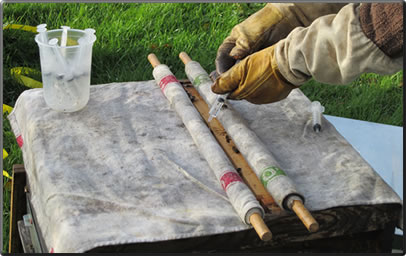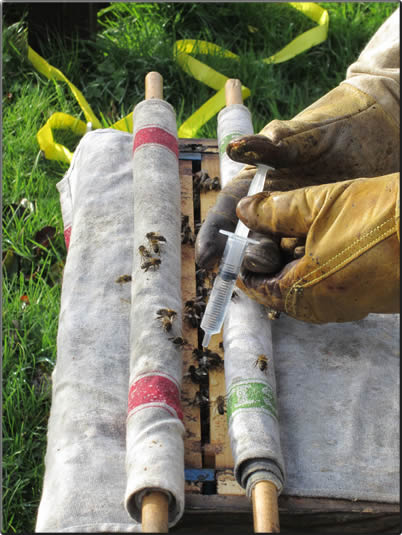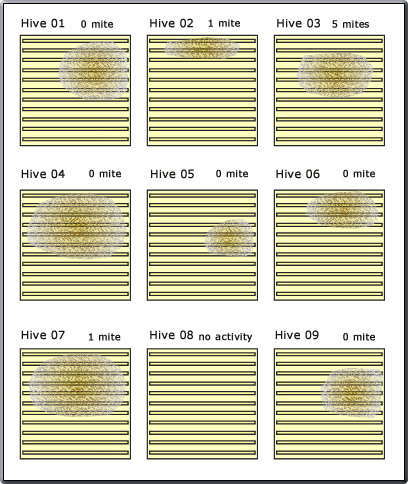Seasons: Winter
Varroa treatment
In the first week in December a varroa screen is placed under each brood box.
Each colony is then treated with 3.2% oxalic acid in a 1:1 sugar solution by the trickle method; 5ml of warm solution/ seam of bees.
A calculator pop-up can be used to work out the most economical amounts.
The screen is left in place for 5 days to check on the mite drop. The sample results can be viewed here. It will be noted that the acid is extremely affective; there being an immediate mite drop but very few mites are seen after the 5 day period.
The actual technique is pictured on the left. There is no need to smoke the bees. The top photo shows the set up. After the removal of the crown board, two roller clothes (made from tea towels glued to wood dowels) are used to cover the top of the brood box. Conveniently they can be rolled across the box so exposing the seams of bees one by one, or rolled up close together to seal off the bees. In the present set up the red cloth was used first to cover the whole brood box and then the seams of bees were treated starting from the back of the hive.
The lower photo shows the operation close to completion with only two more seams to go.
The warm oxalic acid solution is ready for use in ten 5 ml syringes (seen in the beaker). The application per seam of bees only takes about 10 seconds and the whole operation takes about two minutes. After the dousing with the oxalic acid the bees disappear down between the frames allowing the crown board to be replaced without any difficulty.
The weather on this day was quite mild T = 9 °C. Perhaps it might have been better to wait for a colder day when the bees were less active. The weather generally was very mild for this time of year; on some days there was an audible hum coming from the apiary with the bees appearing to be very busy.
See more information on oxalic acid Varroa 2.
And some results: Varroa 4.
A review of the use of oxalic acid for the control of varroosis can be read in this comprehensive article [28}.
In the first week in December a varroa screen is placed under each brood box.
Each colony is then treated with 3.2% oxalic acid in a 1:1 sugar solution by the trickle method; 5ml of warm solution/ seam of bees.
A calculator pop-up can be used to work out the most economical amounts.
The screen is left in place for 5 days to check on the mite drop. The sample results can be viewed here. It will be noted that the acid is extremely affective; there being an immediate mite drop but very few mites are seen after the 5 day period.
The actual technique is pictured on the left. There is no need to smoke the bees. The top photo shows the set up. After the removal of the crown board, two roller clothes (made from tea towels glued to wood dowels) are used to cover the top of the brood box. Conveniently they can be rolled across the box so exposing the seams of bees one by one, or rolled up close together to seal off the bees. In the present set up the red cloth was used first to cover the whole brood box and then the seams of bees were treated starting from the back of the hive.
The lower photo shows the operation close to completion with only two more seams to go.
The warm oxalic acid solution is ready for use in ten 5 ml syringes (seen in the beaker). The application per seam of bees only takes about 10 seconds and the whole operation takes about two minutes. After the dousing with the oxalic acid the bees disappear down between the frames allowing the crown board to be replaced without any difficulty.
The weather on this day was quite mild T = 9 °C. Perhaps it might have been better to wait for a colder day when the bees were less active. The weather generally was very mild for this time of year; on some days there was an audible hum coming from the apiary with the bees appearing to be very busy.
See more information on oxalic acid Varroa 2.
And some results: Varroa 4.
A review of the use of oxalic acid for the control of varroosis can be read in this comprehensive article [28}.
December, January and February
Pollen
Being the opportunists that they are, the bees make use of any break in the weather to continue to collect pollen mainly from the snowdrops at this time of the year.
Being the opportunists that they are, the bees make use of any break in the weather to continue to collect pollen mainly from the snowdrops at this time of the year.
Winter clustering
During the winter months the ambient temperature drops. The colony adopts two mechanisms to ensure its survival.
1. When the temperature falls below 14 °C the bees start to cluster; the lower the temperature the tighter the cluster. The hairs on the bees' bodies interlock; the bees on the outside of the cluster thus providing an insulating layer.
2. The bees vibrate their flight muscles and so generate metabolic heat. So maintaining the temperature at the surface of the cluster above the minimum required.
Black bees do not need to be kept warm during the winter months by having the hive insulated. But rather kept cold to encourage them to cluster. What is important is that the colony has been well fed and that the hive is kept dry and well ventilated to prevent condensation on the inside of the brood box.
A varroa screen (corex) can be safely kept underneath the OMF for the duration of the winter and monitored every two weeks. The debris will show where the bees are clustering and where stores are being opened. The mite drop can also be monitored. On careful inspection two different coloured debris might be seen. A pale cream drop would indicate stores are being opened, whereas a light brown drop would indicate brood is emerging. After each inspection clean the correx with warm water containing washing-up liquid and a little bleach.
It is especially pleasing to view the screen in February. At this time one can expect to see the area of the debris drop increasing. This would indicate that is queen is present and the brood nest is expanding.
During the winter months the ambient temperature drops. The colony adopts two mechanisms to ensure its survival.
1. When the temperature falls below 14 °C the bees start to cluster; the lower the temperature the tighter the cluster. The hairs on the bees' bodies interlock; the bees on the outside of the cluster thus providing an insulating layer.
2. The bees vibrate their flight muscles and so generate metabolic heat. So maintaining the temperature at the surface of the cluster above the minimum required.
Black bees do not need to be kept warm during the winter months by having the hive insulated. But rather kept cold to encourage them to cluster. What is important is that the colony has been well fed and that the hive is kept dry and well ventilated to prevent condensation on the inside of the brood box.
A varroa screen (corex) can be safely kept underneath the OMF for the duration of the winter and monitored every two weeks. The debris will show where the bees are clustering and where stores are being opened. The mite drop can also be monitored. On careful inspection two different coloured debris might be seen. A pale cream drop would indicate stores are being opened, whereas a light brown drop would indicate brood is emerging. After each inspection clean the correx with warm water containing washing-up liquid and a little bleach.
It is especially pleasing to view the screen in February. At this time one can expect to see the area of the debris drop increasing. This would indicate that is queen is present and the brood nest is expanding.
Queen starts to lay
At the start of the new year if all is well, the queen at the centre of the cluster will lay a few eggs. And so begins another annual cycle for the colony.
At the start of the new year if all is well, the queen at the centre of the cluster will lay a few eggs. And so begins another annual cycle for the colony.



Stonyhurst February 2018 : Colonies coping well in the snow during a prolonged cold spell.
However, the weather in March and April turned very cold with bitter winds from the east-
the so-called 'Beast from the East'. Resulting in some losses.

The diagram above shows the pattern seen for 9 colonies monitored over a 5 day period at the beginning of January. Only colony 08 gave cause for concern where no debris was seen. It seems likely that this colony has already died out. The size of each cluster can be estimated from the area of the debris.
All colonies had their entrances at the top of the diagram facing east.
All colonies had their entrances at the top of the diagram facing east.
Winter stores and possible winter feeding
February is a critical time for the colony. The queen will have started to produce the first brood. The winter stores are being used up to feed the new brood. If there are not sufficient stores then the colony reaches a crucial point which could result in starvation. It could prove prudent to offer the colony a supplementary feed. It is still too cold to offer syrup but fondant will be readily taken down.
Baker's Fondant can be purchased in 12.5 kg blocks and easily cut up into smaller pieces of about 1 kg weight. Each is placed in a freezer bag and placed over the feed hole above the crown board. The fondant benefits from the warmth from the brood nest and the bees slowly consume this if needed.
February is a critical time for the colony. The queen will have started to produce the first brood. The winter stores are being used up to feed the new brood. If there are not sufficient stores then the colony reaches a crucial point which could result in starvation. It could prove prudent to offer the colony a supplementary feed. It is still too cold to offer syrup but fondant will be readily taken down.
Baker's Fondant can be purchased in 12.5 kg blocks and easily cut up into smaller pieces of about 1 kg weight. Each is placed in a freezer bag and placed over the feed hole above the crown board. The fondant benefits from the warmth from the brood nest and the bees slowly consume this if needed.
Annual Assessment
This is the time to make an annual assessment of the year's work. Were all objectives achieved?
Winter 2020/21 was one of the wettest on record but Spring one of the sunniest and driest on record. Such that in the Spring the bees did very well and some Springtime honey was taken off. Swarm control was challenging as always; the bees always seemed to be one step ahead. But all in all this was a satisfactory season.
A summary of each of the 17 colonies can be seen by clicking on the respective hive below!
This is the time to make an annual assessment of the year's work. Were all objectives achieved?
Winter 2020/21 was one of the wettest on record but Spring one of the sunniest and driest on record. Such that in the Spring the bees did very well and some Springtime honey was taken off. Swarm control was challenging as always; the bees always seemed to be one step ahead. But all in all this was a satisfactory season.
A summary of each of the 17 colonies can be seen by clicking on the respective hive below!